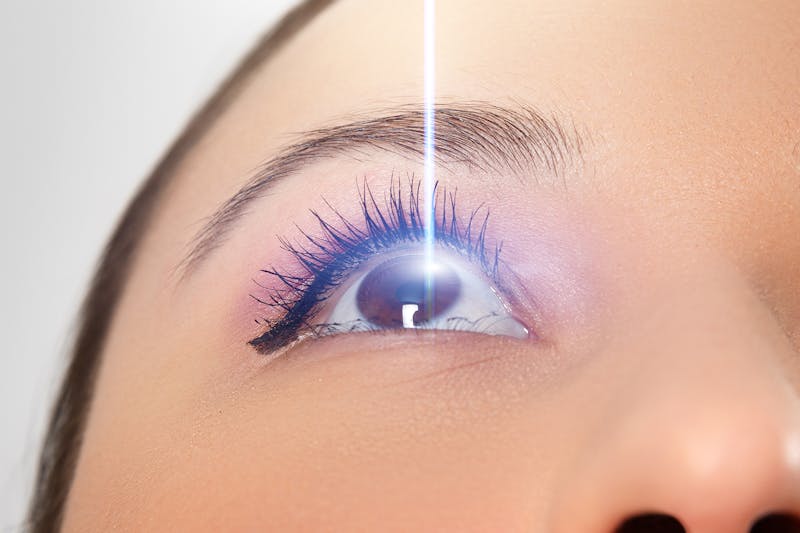
If you wear glasses or contact lenses, you’ve probably found yourself dreaming of a quick fix for your eyesight. For many people, LASIK surgery is just that fix. But
Before diving into possible outcomes, it’s important to first ensure that you are an eligible candidate for LASIK and that the surgery can address your particular vision needs. To determine if you’d be a good candidate, meet with an experienced eye surgeon for an evaluation. Ask all questions you have so that you fully understand whether LASIK is a possible solution for you.
Still, before you speak with an eye surgeon, it can be helpful to have a general understanding of
What Can LASIK Eye Surgery Fix?
LASIK eye surgery can help improve a variety of different common vision issues, but it cannot fix everything. In some cases, your vision may not be correctable with LASIK — this may be because your type of vision correction cannot be accomplished by LASIK, or because you have a health condition that makes your eyes unsuitable for LASIK surgery. Because not everyone is a good candidate for LASIK, it is essential that your eye surgeon conducts a thorough initial consultation and evaluation.
In that case, what vision problems can LASIK surgery fix? Generally speaking, if you are determined to be a good candidate for LASIK surgery, it is a highly effective solution for a number of very common refractive vision problems. While there are exceptions, it’s helpful to know:
Astigmatism
Astigmatism is caused by a cornea that is curved unevenly, which interrupts the proper focus of light on the retina. In this case, LASIK can reshape your cornea so it curves evenly, providing you with clear vision.
Hyperopia (Farsightedness)
Farsightedness is caused when your eyeball is shorter than average or when your cornea is flatter than it should be. As a result, the light focuses behind the retina, and objects close to you look blurry while objects in the distance appear sharper. In this case, LASIK can steepen the curve of your cornea to improve vision close up.
Myopia (Nearsightedness)
Nearsightedness is caused when your eyeball is longer than average or when your cornea curves more than it should. As a result, the light rays focus in front of the retina and objects appear sharp up close, but blurry in the distance. In this case, LASIK is able to reshape your cornea, flattening the curve, to improve your distance vision.
Presbyopia
Presbyopia is when the lens of your eye loses elasticity and becomes stiff, making it hard to focus on very small or very close objects. This is typically caused by age and cannot be stopped by LASIK. However, LASIK can help correct the vision issue by fully correcting the distance vision in your dominant eye, while creating nearsightedness in the other eye for sharper vision close up. This procedure is called Monovision LASIK.
What Can LASIK Not Fix?
While LASIK is an excellent solution for many common refractive vision problems, it cannot solve all issues with your vision. In certain cases, LASIK will not be a good match for your vision correction needs. So, what can LASIK not fix?
Cataracts
Cataracts are a clouding of the eye’s lens caused by age, injury, or disease. While cataracts do not pose any danger, they do impede your vision and surgical treatment may eventually be required. LASIK surgery cannot correct this clouding, but cataract surgery, which involves replacing the clouded lens with an artificial lens, can be quite successful. If you still need refractive vision correction after cataract surgery, ask your eye surgeon if you are still eligible for LASIK.
Glaucoma
Glaucoma is a disease that damages the optic nerve, which cannot be treated with LASIK surgery. You should see a specialist to ensure your glaucoma is properly treated as it can result in vision loss or even blindness. However, you may still be eligible for LASIK for refractive errors after your glaucoma has been treated and controlled.
Keratoconus
Keratoconus is caused when your cornea becomes thin and bulges in a cone-like shape. This causes the light to focus incorrectly. Unfortunately, LASIK surgery cannot correct this issue and could make it worse, so it’s important that your eye surgeon instead monitor your condition to ensure the correct treatment.
Lazy Eye
Lazy eye, also called amblyopia, is caused when the vision in one eye or both eyes does not develop correctly in childhood.
This can be the result of:
- A muscle problem, causing the eyes to point in two different directions
- A droopy eyelid blocking vision in one eye
- A cataract in one eye
- Refractive errors that are worse in one eye
All of these issues cause one eye to become significantly more dominant, while the other eye stops developing correctly. LASIK cannot correct a lazy eye, but may eventually be able to correct a refractive error, if necessary, once the child is an adult.
Screening: What Can LASIK Eye Surgery Fix
In order to qualify for LASIK surgery, your eye surgeon will need to evaluate your eyes. Typically during evaluation, your surgeon will screen you for a number of different potential issues. Your eyeglass prescription is one piece of the puzzle — but your doctor will also need to evaluate several other factors, including:
- Whether your prescription is stable. If your prescription is fluctuating and has not remained stable for two years because of hormones, age, or another reason, you will not be eligible for LASIK.
- Whether your eyes are healthy. If your eyes are diseased, injured, infected, or unhealthy for any other reason, that must be resolved, if possible, before you can be eligible for LASIK.
- Whether you have dry eyes. While dry eye does not eliminate you from being a candidate for LASIK, it can be a complicating factor. As such, your doctor will want to know.
- How thick your corneas are. Your cornea must be thick enough for a successful flap to be made for the surgery.
- The size of your pupils. Large pupils can be a complicating factor for LASIK, although it does not immediately eliminate you from being a candidate.
- Any light distortion you experience. If you see glare, ghosting, halos, or starbursts around light sources, whether during the day, in dim light, or at night, your eye surgeon will want to know.
Once you and your eyes have been properly screened and evaluated by your eye surgeon, they can decide whether LASIK is the right path for your vision correction needs. Make sure you ask your eye surgeon plenty of questions during your initial consultation and while your eyes are being evaluated. Even if LASIK isn’t right for you, you may have other laser eye surgery options like PRK to help improve your vision.
So, complimentary initial consultation at Dello Russo Laser Vision. One of our World Class LASIK surgeons can talk to you about your vision needs and the personalized vision treatment plan they could develop for you. Contact us to discover how you can improve your vision today.
